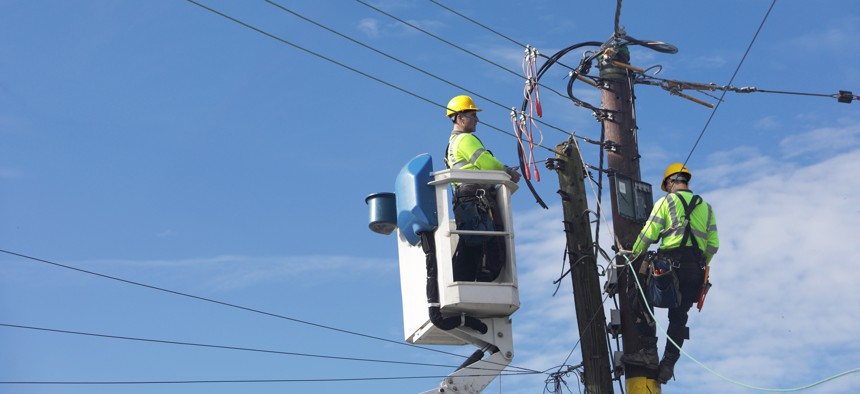The ‘Silver Tsunami’ Expected to Hit the Infrastructure Sector

Peter Cade/ Getty Images
Roughly 17 million infrastructure workers will retire in the next 10 years, raising worries about who will erect and maintain America’s roadways and buildings.
The bipartisan infrastructure act and other recent legislation is funneling billions of dollars to state and local governments to build projects around the country. But, according to a Brookings Institution report, a critical question is being ignored: Who is going to maintain all those roads, bridges, buildings and water lines?
The Bureau of Labor Statistics projects that 1.7 million people employed in the infrastructure sector will leave their jobs each year between 2021 and 2031.
“That means 17 million infrastructure workers will need to be replaced over the next decade,” the report said. That’s more than the 16.6 million people employed in the sector last year that hold jobs like electricians, plumbers and maintenance workers.
“If you think about a transportation department or a water utility or a telecom, it's not just about building something in the next few years. It's also about maintaining all of this because infrastructure ideally is designed to be long-lived,” said Joseph Kane, the report’s author and a Brookings Metro fellow.
Driving the exodus, in part, is the age of the infrastructure workforce, which tends to skew “older, male, and white,” according to the report. For instance, nearly three-fourths of transit and intercity bus drivers are 45 years old or older, as are 55.7% of power distributors and dispatchers and 53.8% of rail yard engineers.
Transit agencies will be hit by the “silver tsunami” first. Up to 50% of bus maintenance employees are eligible to retire in the next three to five years.
But infrastructure workers aren’t just retiring. The number of workers leaving jobs in construction, transportation, warehousing, and utilities for other jobs grew by almost 20% last year. The culprit, says the report, is the difficulty of the jobs.
Septic tank workers, electricians, telecommunication line installers and highway maintenance workers, noted the report, “face long hours in hazardous conditions.” Federal agencies and state and local governments need to address this problem, said Kane, or “we're going to be piling on more workers onto a sinking ship.”.
The report finds that a major problem in finding replacements is that, even though infrastructure jobs pay relatively well, younger people don’t seem interested in working in those jobs. Only 11% of infrastructure workers are 24 years or younger.
The report attributes this to the fact that many of these jobs appear "dirty and dangerous." In addition, requirements to get electrician and other licences might deter younger workers because they differ from state to state. Young workers would have a hard time moving to other parts of the country.
“A lot of younger individuals value flexibility in their careers. They may not know whether they want to work for the same employer for five or 10 years, let alone whether they even want to work in the same city or state,” said Kane, who called for the development of national licensing standards. “If you need to move with your family, there'd be a greater ability to do that.”
Not many women or minorities are entering the professions, either. Only 18.5% of infrastructure workers are women, which Kane called “a huge glaring statistic, considering they make up half of all of the nation’s workers.”
Similarly, Black, Latino, and Asian Americans make up a lower percentage of infrastructure workers than in other professions, according to the report.
As it stands, state and local governments aren’t prioritizing training and hiring new workers. Instead, they are focused on just getting the surge of infrastructure projects done.
“Their priority right now is getting the money in the door and addressing, in many cases, a backlog of projects,” Kane said. “I think that lends itself to a business-as-usual approach. Are they actually going to take a step back to think, ‘How are we reaching more different types of workers?’”
To get states and localities to focus on the issue, the report recommends, among other things, that federal agencies prioritize awarding competitive infrastructure grants to applications that “stress workforce development.”
State agencies, meanwhile, “need to look past compliance and the bare minimum of getting projects done” and use infrastructure dollars to create “durable workforce solutions." Wisconsin, for instance, has created several programs to prepare underrepresented groups to get jobs in construction and transportation.
For their part, cities should increase outreach to underrepresented people, and provide job training, internships, and mentorships to attract and retain workers.
“If I’m hiring a worker, I need to be thinking, ‘How can this worker actually pick up skills and experience over time, so they can grow their careers and be the managers of tomorrow,’” Kane said. “Workers want to feel valued. They want to have opportunities to grow their careers.”
Kery Murakami is a senior reporter for Route Fifty.
NEXT STORY: How States Can Fill the Tech Workforce Gap






